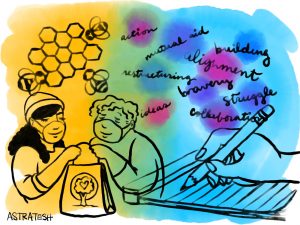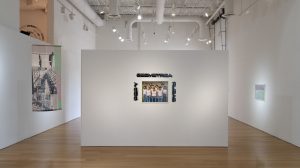“Beyond the Page” digs into the process and practice of writers and artists who work at the intersection of literary arts and other fields. For this installment, I interviewed three members of Generation LatinX, a comedic ensemble of English- and Spanish-speaking Latinx performers working across improv and sketch: Mishell Livio, executive producer and creator; Maria Konopken, production director; and Jesse Pazmiño, writer and graphic designer. Toward the end of last season, Andrés Lemus-Spont and I attended a Generation LatinX show and then stayed late to talk with Mishell, Maria, and Jesse about the origins of the group, its goals (beyond being funny), the process of creating the multimedia show, and what’s coming up in Season 4.
Check out Season 4 of Generation LatinX at iO, Tuesday nights at 10pm, beginning August 21. Find @GenerationLatinX on Facebook and Instagram and @GenLatinX on Twitter. This interview has been edited for length and clarity.
Marya Spont-Lemus: To start, I’d love to hear in your own words, Mishell, what is Generation LatinX and how did it come to be?
Mishell Livio: Sure! Generation LatinX is an ensemble of English- and Spanish-speaking artists that believe in creating a strong Latinx presence across entertainment platforms. We strive to diversify both the content and the audiences to build an atmosphere reflective of our culture and point of view. Latinx is the non-gendered way of saying Latino or Latina, so it’s just inclusive of all people that have different Hispanic heritage.
I’ve been performing since I was a little kid. And the only Hispanic things I had seen for a very long time were in Spanish, which doesn’t include a lot of Hispanic people. That’s just not all of our culture — 2nd-, 3rd-, 4th-generation. They were excluded, which didn’t seem fair [laughs] for a diversity program, an inclusive program, to exclude a lot of people. So I wanted to create something for this generation of people that I saw. They speak English, they speak Spanish, they’re young, they’re old, they’re gay, they’re straight, they have all religions — and that’s really the point of it, is just to encompass this generation of Latinx performers and artists.
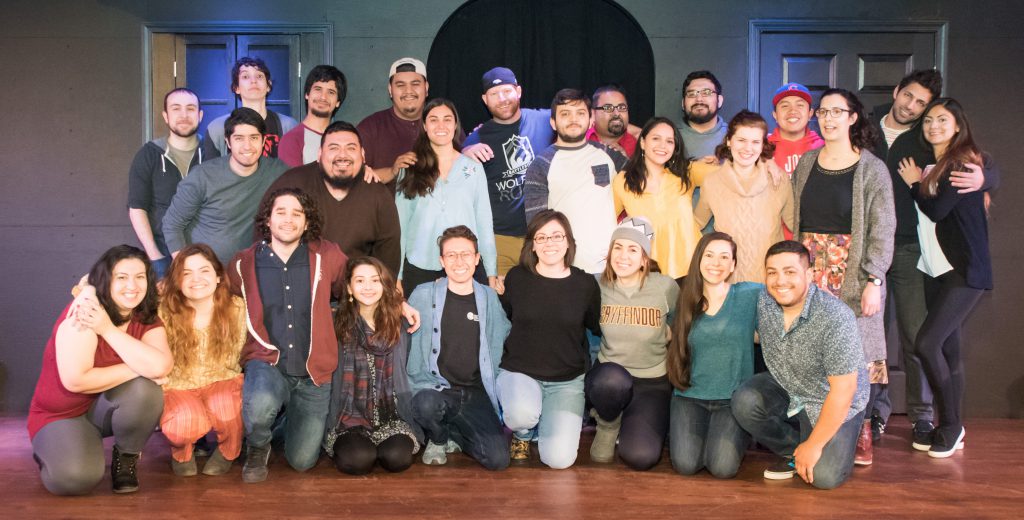
Marya Spont-Lemus: When you started Generation LatinX, did you have a core set of people in mind that you had seen perform and wanted to form a troupe around? Did you hold auditions? A combination?
Mishell Livio: Yeah, I had been performing at indie theaters all over town, and I had seen a bunch of different people. At first I workshopped the idea with the Hispanic performers I knew, and from that workshop I sent out audition notices and tried to contact every Hispanic person [all laugh] that I knew, that I could think of, that I had ever met, that anyone knew. It was just this network of word of mouth, really, and it grew from there. And Generation LatinX is on a quarter system, so every quarter I hold auditions and we bring in more people.
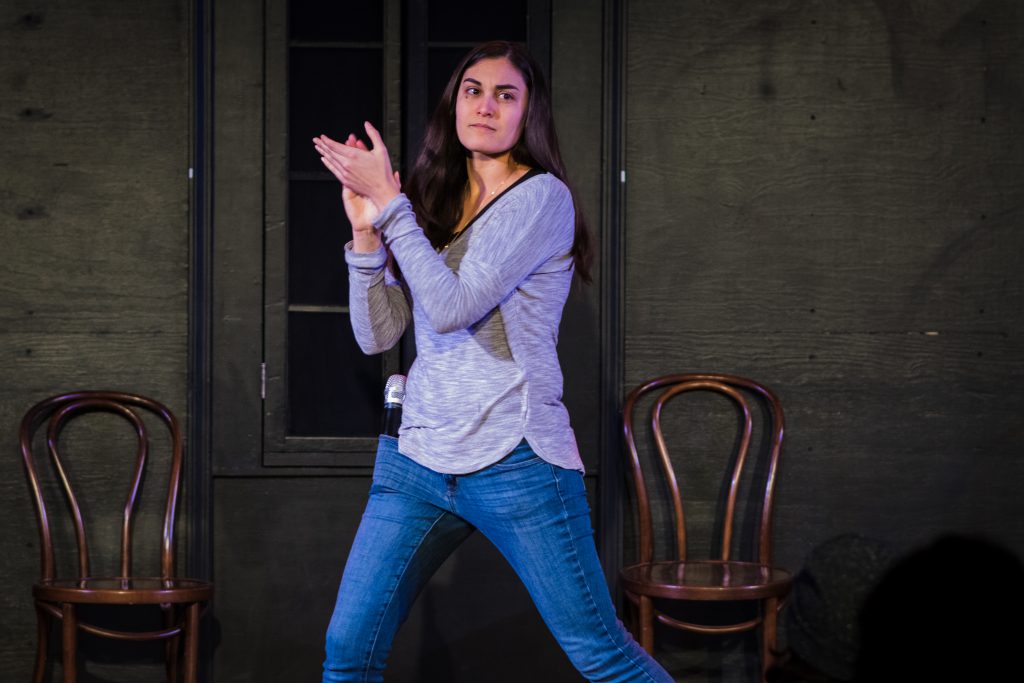
Marya Spont-Lemus: When did it formally start, or when did you start thinking about it? I guess, what is the path to being here at iO, about to start Season 4?
Mishell Livio: I mean, Hispanic things have always been in my life, but just this being part of– Like, being American but not being American, but being here. Being Hispanic but not being Hispanic. I grew up in Tucson, Arizona, which is very close to Mexico, but not Mexico. And I grew up in a mariachi restaurant, but I don’t speak Spanish. [laughs] So, I would memorize Spanish not knowing what I was saying. For me, being biracial has meant that I’m too much and not enough; there’s a constant push and pull of simultaneously being and not being accepted by both cultures. It’s just always been a part of me.
And when I was in Los Angeles, I was a model on a show called “Model Latina,” on Sí TV, which was by a now-defunct company that was specifically for 2nd- and 3rd-generation Latinx people who spoke English. So it was in English, for Hispanic people. And I thought, “Oh my gosh! This is amazing! This company is so great! I love this! I want to do this!” I was 19. It was just so powerful and so empowering to see. Just, all of these different cultures are so different. And I was like, “Wow! Puerto Ricans are so different than Cubans and so different than Venezuelans….” And yet — we’re similar but we’re different. It was just beautiful. That company doesn’t exist anymore, and I’ve always just wanted to do that, do something like that. And I finally made it happen! Basically I pitched the idea and someone said yes to me. And I went, “Oh! Okay, now I have to make it happen.” [laughs] I believe I started reaching out to people and organizing in May 2017, we had our first practice in July, and our first show in August 2017.
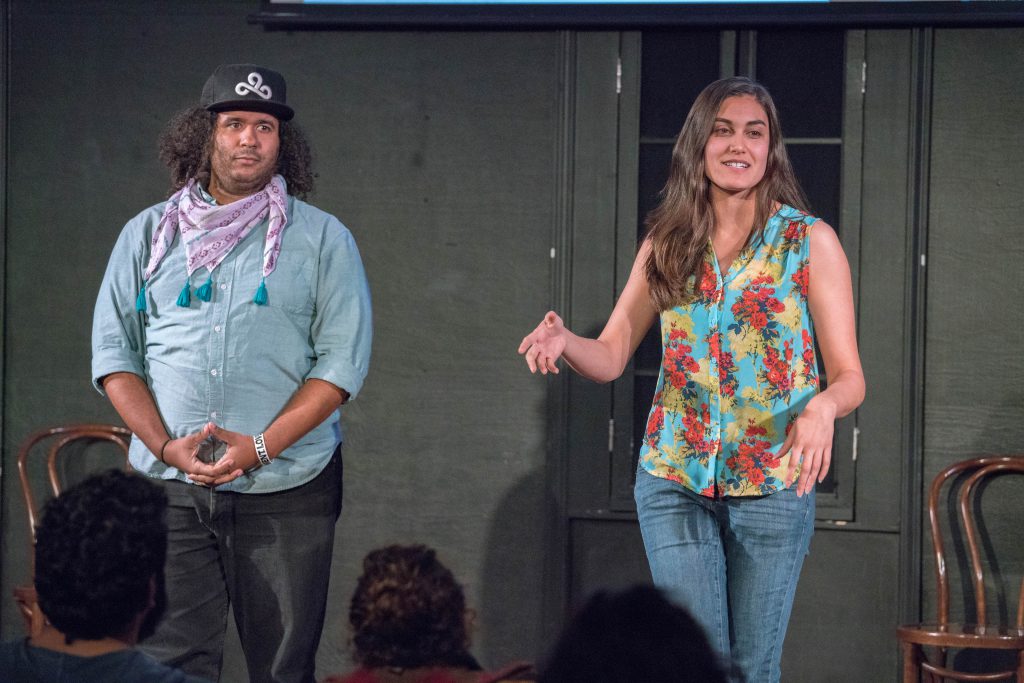
Marya Spont-Lemus: And it’s always been here at iO?
Mishell Livio: It was at Under the Gun Theater when it started, then it moved to iO. Now this is our home — I like having a hub — but we perform different places. I would love to get involved in various educational programs, through colleges and schools and stuff.
Maria Konopken: Especially because representation matters, so you’re seeing it in places that maybe you don’t always, like theater and school. And when you see your stories told through people who look like you, it’s really relatable and then you can get involved in it. I think that’s a big part that Generation LatinX does — that people maybe aren’t at iO but they’ll see the group at another theater and be like, “How can I help grow or be a part of that?” Because representation matters, and finding people you can relate to matters, and culture’s a big thing. And while some of us in the group are Mexican, and Puerto Rican…. If it was a Venn diagram, [all laugh] there are parts of all of us that are relatable.
Mishell Livio: Yeah! It is like a Venn diagram. That’s beautiful. There are similar things and there are different things. But I think it’s important to have a hub and to have a place where people can find us. “Ooh, where can I see them?” Tuesday nights! At iO! And that’s currently where we are.
Video: “What is GLx?”: The video thumbnail shows three performers in black-and-white cut-outs against a red background. A white and green “GLx” logo is in the top left-hand corner and the superimposed title, “What is GLx?”, is displayed against a light green banner in the bottom right-hand corner. The performers look above, past, or at the camera, and the hands of the performer in the center foreground are raised. Video courtesy of Generation LatinX.
Marya Spont-Lemus: Awesome. I have a lot of questions about the ensemble and how you craft shows, but maybe we can pause and hear how each of you came to improv or to this troupe specifically, if you didn’t start it? What your roles are in it? Whatever you want to share.
Maria Konopken: So, I started my improv career — it’s so weird to say [all laugh] — in Arizona. I’m from Phoenix, and I started there. This man named Jose Gonzalez came to my work and did a workshop and everybody thought it was really lame but I was like, “This is the coolest thing I’ve ever seen.”
Marya Spont-Lemus: It was a professional development “teambuilding” improv thing?
Maria Konopken: Yeah. And I was like, “I gotta figure out how to do this, because I think it’s great.” [all laugh] So I got involved in a theater there.
Mishell Livio: Was it Torch?
Maria Konopken: At The Torch Theatre in Phoenix — what uup? [all laugh]
Mishell Livio: They’re great.
Maria Konopken: Yeah. It’s a tiny theater but it’s just a fun place, very family oriented. And I was reading books and articles on improv and everyone said, “You gotta go to Chicago, you gotta go to Chicago.” So I came here for a summer — I told my job like, “Oh, I’m just going to be there for a summer, pay me!” and they were like, “Uh, okay” — and took classes at iO. And any show that was playing in the summer of 2013, I saw it and I probably saw it twice. And it was so cool! But I do remember thinking, “Oh, there’s not really people that look like me…but sadly on some level I am used to that because people don’t look like me on TV.”
Then, a year later, I moved from Phoenix to Chicago and that sort of idealistic bubble got burst, because like, “Okay, now I live here, and I’m in classes and the worst of the worst that could happen is happening to me.” In Phoenix, I just had to worry about being someone’s girlfriend or wife in a scene. Here, I had to worry about being a maid, a janitor, just playing on stereotypes. Or I would try to say something that had to go with what I understood it to be, and then it got made fun of. I am left asking the question, “Why do I have to know your culture and my own?” So that was really hard for me. And then, also, there’s no representation on stage. Like I knew the five Latin performers that performed at iO — and one of them was Damian [Anaya] who performed with us tonight, so that was kind of full circle when he first performed with us. But yeah, there weren’t many.
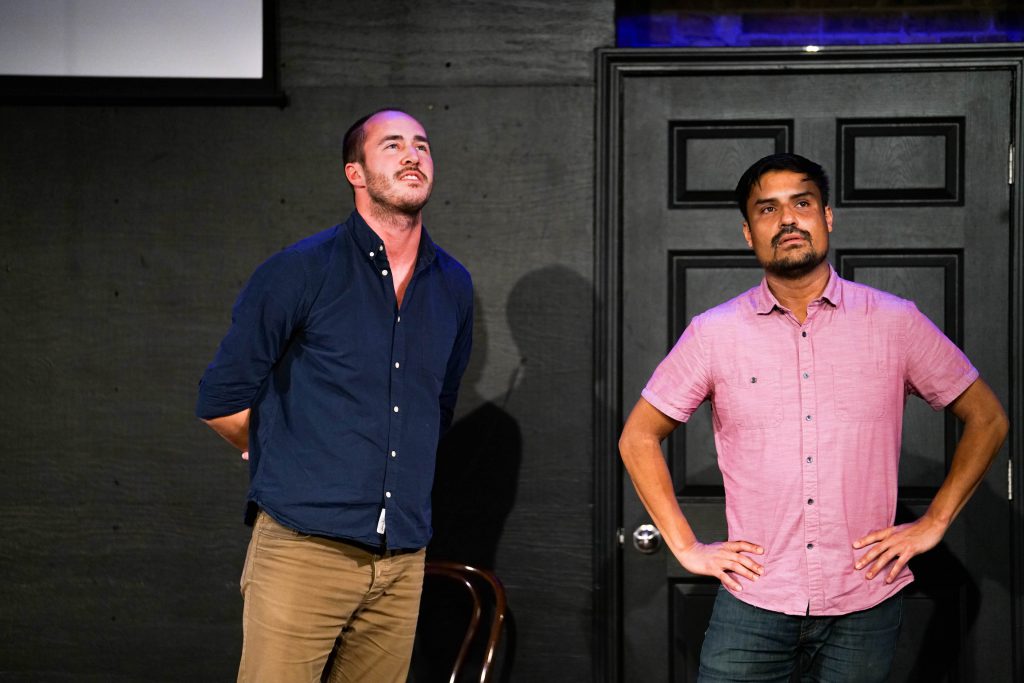
Mishell Livio: That’s why representation is just so important. Because there are a lot of us who might be the only Hispanic person, the only person of color — in a show, in the audience, in a room. And people are very quick to point out how, “Hey, you’re different.” And you go, “Oh, am I? [Andrés laughs] Well, thanks for telling me that.” Why would you need to tell someone that they’re different? But then you start internalizing that if people keep telling you. “Oh, I guess I am different.”
Maria Konopken: And that causes its own anxiety, because you’re like, “How am I supposed to perform? I don’t want to perform like that, I want to perform this way. But if I perform my way will I not get cast in anything?” I think the movement that Generation LatinX is part of — that we’re seeing the last two years in Chicago — is people creating their own. So when Mishell created her own, and she said, “I want you be a part of it,” I was like, “YES! I don’t know how, but I’m in.” [Andrés laughs] I was really excited.
Marya Spont-Lemus: It strikes me, too, even just thinking about the improv form versus, say, auditioning for a play — where things might change once you get into rehearsals, but for the most part you have a sense of what you’re auditioning for. But it does seem like, if you’re on the improv stage, somebody can just assign a role to you in a moment, where you have to then react to it immediately and in front of an audience.
Mishell Livio: Right. Which is why representation is very important. One of the biggest things of this show is, “We’re…people!” [all laugh] People are people are people are people! It doesn’t matter what language you speak. We are everything.
Maria Konopken: Right. And especially in a form like improv that’s like, “You can be anything!” and then to be put in a box it’s like, “Wait, what? I can be a dragon, I want to be a dragon, you know?” I like playing animals. [all laugh]
Marya Spont-Lemus: Or jumping out of windows, as we saw tonight.
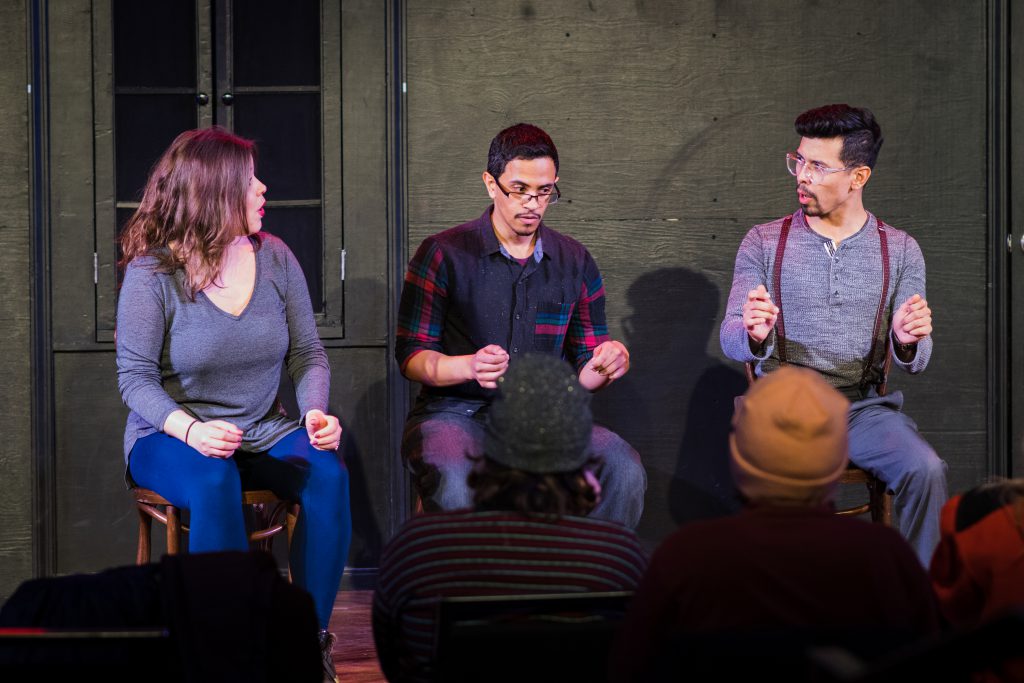
Maria Konopken: Exactly. In improv and in this program you get to do that. And with this program there’s people who haven’t taken improv classes before or money’s been an issue or location’s an issue — and they’ve come to the program and I’ve seen them grow from being an understudy to the star of the show that day! Or whatever. Because I think people are willing to put in the work and hone their skills, they just need the opportunity. That’s a big thing that I think Mishell’s done a really good job at, is giving people the opportunity.
Mishell Livio: And education is very important to me. Both my parents are teachers, my uncles are teachers. So it’s not just like, “Hey, you’re Hispanic! Get on the stage!”
Maria Konopken: Right.
Mishell Livio: You have to earn it. We are sitting in the biggest theater at this place, at iO Chicago! I’m not just going to put anyone on the stage. We have weekly rehearsals, you have to audition to get in, and every season you have to re-audition, so even if you made the team one season you might not make it next season. I need to know that you’re dependable! Because even though it’s fun it’s a job, right? So, I mean, you have to say yes to people’s ideas and be, like, a good, decent person. And, also, you have to go through classes! Not just through our program — not just our rehearsals — but we encourage people to go through classes here at iO and at different theaters — comedy theaters, acting schools, dance and martial arts studios, everywhere! Which is neat because people do bring different perspectives — not just their own, but educationally as well. Which is really cool.
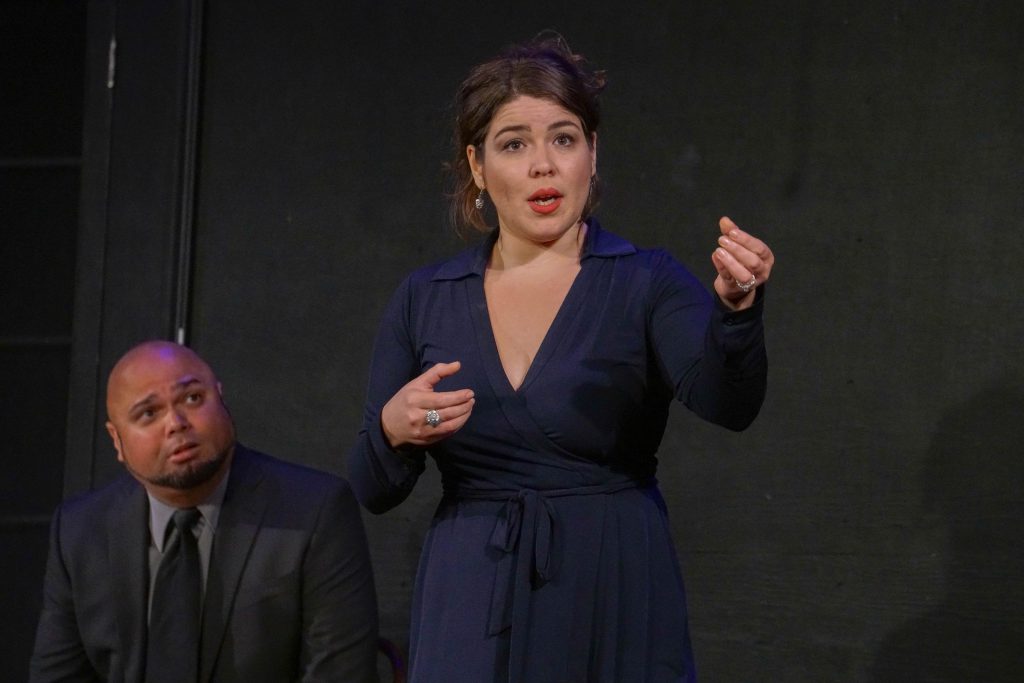
Marya Spont-Lemus: Yeah, that’s really interesting. I think I didn’t get the full sense from the website of how much your work goes beyond the live show. I guess part of it is just everything that goes into being an “ensemble.” But also, using the word “program” or talking about understudies — which I didn’t realize improv shows had — or those structures of entry and continual training and rehearsal within Generation LatinX.
Maria Konopken: Yeah. And especially professionalism is a big thing because often — and you hear this with this group and with other groups — it’s like, “Oh, you’re getting this opportunity because you’re people of color.” Well, if you look at how those groups got started, they got started often because there wasn’t an opportunity. And, with that opportunity, they were able to not only show, “Hey, I’m talented,” but also work hard. That’s a big thing with professionalism. And when I coach, I start class on time. I tell them, “When you go to audition, this is what you need to do.” Mishell provides workshops and help on resumes. And it’s great that we have that in this insular world because it’s like, “Oh, we’re very talented and we’re having fun,” but when we go outside this world of Generation LatinX we’re a representation of that. Which is really hard, because you’re like, “Oh, I have to represent a whole culture?” Not only do you have to be good, but if you’re professional you stand out even more.
Mishell Livio: I never want anyone in my ensemble to go to an audition — to go to any other sort of job opportunity — and people to say, “Oh, you got this because you’re Hispanic.” “No, I got this because I’m great. And I work really hard. I’m on time, I’m professional.” I look at people’s resumes, like Maria said, and I’ll say, “Take this off, do this, rearrange that. What is this picture?! Get a new picture.” [all laugh] I’ve brought in photographers and I’ll get ensemble members new headshots. I want these people to succeed so badly. And you have to be great! Because there are so few slots, for us. So you’d better bring it!
Video: “Chola Wisdom”: The video thumbnail shows two performers in black-and-white cut-outs against a green background. A white and purple “GLx” logo is in the top left-hand corner and the superimposed title, “Chola Wisdom,” is displayed against a purple banner in the bottom right-hand corner. The performer in the right foreground looks down at the camera. The performer in the left background wears sunglasses. Video courtesy of Generation LatinX.
Maria Konopken: What’s also great with Generation LatinX is there’s another team for video and production. There’s an opportunity to not only learn writing but also the structure — “How can we make a video?” — and then from the production end — “What goes into making a video?”
Mishell Livio: And that’s a beast.
Maria Konopken: But it’s fun. That opportunity’s there, but you have to be willing to work for it. Because there’s other people — as this community grows — who are like, “I want that spot. I’ll work twice as hard for it.”
Marya Spont-Lemus: And how long have you been involved with the ensemble, Maria? Since the beginning?
Maria Konopken: Since it came to iO.
Mishell Livio: Yeah, you weren’t at Under the Gun.
Maria Konopken: Yeah, I had another project to do. But once we came to iO I got involved — so September 2017?
Mishell Livio: Rehearsals started in September and shows here started in October. Yeah.
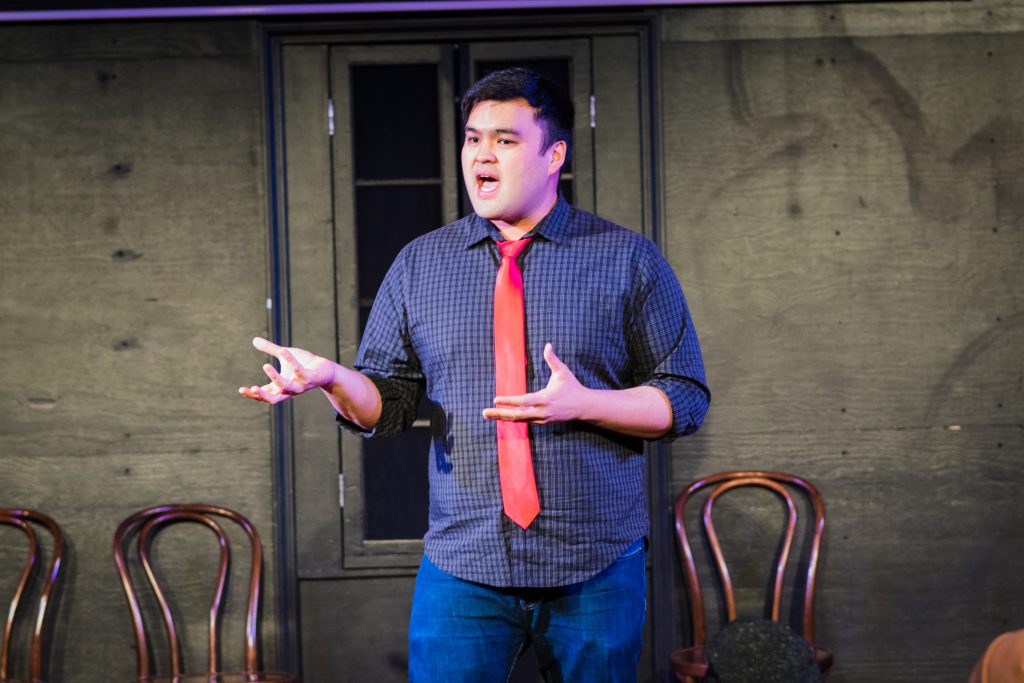
Marya Spont-Lemus: And Jesse, how did you get into improv? How did you become part of this group?
Jesse Pazmiño: Well, I was studying architecture at Illinois Institute of Technology, as you know, and I think in the last year of school we decided to go to Second City to watch a show. I had heard of Second City many times — I knew where it was — but I had never gone. So I go there, I see the show, and I have this epiphany like, “You know what, I could do that.” [all laugh] Like, “Maybe I won’t be good at the beginning, but I think I could get up on stage and do something, and something will work out.”
Mishell Livio: “I have the ability to listen–” [all laugh]
Jesse Pazmiño: Yeah!
Maria Konopken: And make a joke.
Mishell Livio: “–and then respond!”
Jesse Pazmiño: And actually have the urge to get up there. So, when I went back to IIT, I was like, “You know what? As soon as I graduate, I’m going to go to Second City and take classes.” And that’s exactly what I did.
Marya Spont-Lemus: [laughs] You didn’t want to add it onto the studio curriculum?
Jesse Pazmiño: No. That wouldn’t have worked at all. [laughs] No, it had to be afterwards. So I did. I graduated, I went to Second City, I took classes there, and I liked it a lot. The deeper I went in it, the more I opened my eyes to this brand new world of improv and theater — that had been right there in front of me, but I had never seen it because I was, like, in architectureland. And all of a sudden I started seeing all of these parallels to what we were doing in design and what was happening in performance! The way that I think of it is, the designer is the actor and the client is the director. The designer designs something, the actor designs a character. The director or the person that’s coaching you tries to give you that feedback. To me, it’s the same process. And the iteration of that — the coaching, the mentoring — that’s all that we did in architecture school, in putting stuff up on the board, in talking about it. So it didn’t seem to me like such unfamiliar territory. It was just changing the words, but the language was the same.
Anyhow, after some time, I actually had the same question that Mishell did as I was going to these shows. “Wouldn’t it be fun to have a Hispanic team?” Or at least some element of it that would be Hispanic. Because it seemed like, in all these places, that was missing. It seemed obvious to me that that was missing. And I didn’t really think of it much, until one random day, Mishell friended me on Facebook. [all laugh]
Mishell Livio: [shrugs] It’s a thing I do.
Jesse Pazmiño: I didn’t know who she was. I was embarrassed, like, “Maybe I did talk to her but I just don’t remember…?” [all laugh]
Mishell Livio: So then he accepted…
Jesse Pazmiño: I accepted the friend request! And then was like, “Who are you?” And she told me, “I do this program, and you should come audition.” “Yes!” So I did and I became a part of it.
I’ve been with the writing team. The group is so much more than the show that we see onstage. It is a live show, it’s the video sketches that we do, it’s the writers, it’s the mentoring, it’s the friendships that happen in the ensemble itself, it’s the outreach — it’s all of those things together. So I think that, in a way, it fulfills that idea of what Mishell and Maria were saying, that it fills that gap — of representation — or it’s working towards that. But at the same time, it tries to do so much for our development as artists. I think that’s the part that’s so valuable — as a performer, as somebody who’s Hispanic, as a human being I guess — to just have somebody that’s there to support you, and to have a group of people that’s there to support you. So, I think that’s what makes it.
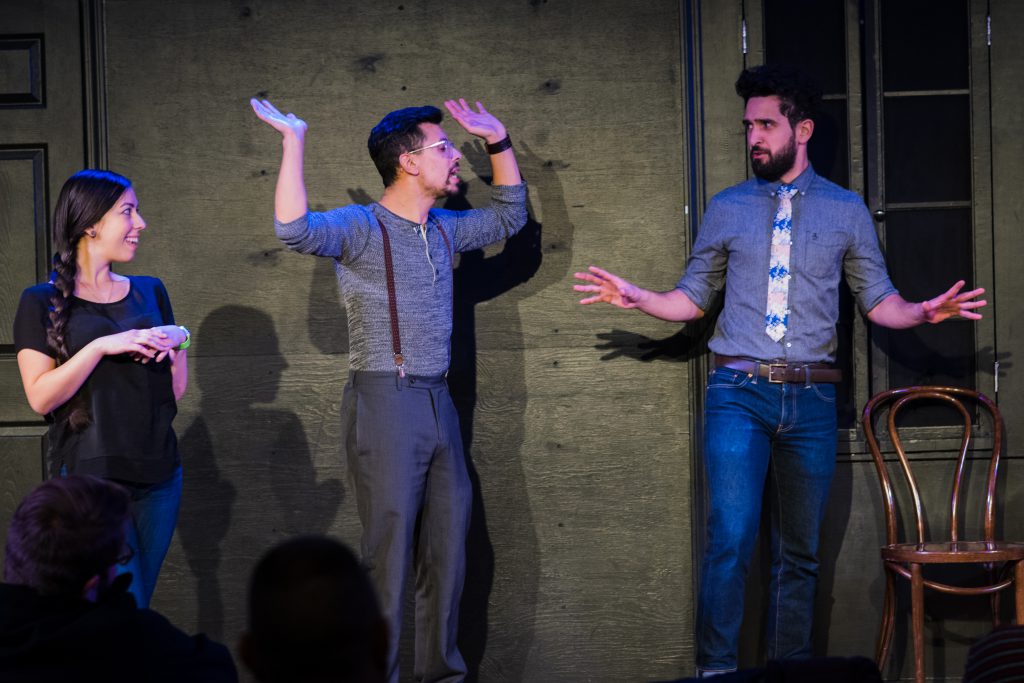
Marya Spont-Lemus: And you brought up that Mishell also, apparently, recruits people! [all laugh]
Mishell Livio: Always. Always constantly.
Marya Spont-Lemus: Add that to the list of things you said earlier. That’s really lovely. How did you hear about Jesse? Did you meet and he forgot you?
Mishell Livio: It must have been because I’m in so many different Facebook groups about improv and performance and I’m just constantly scouring, like, “Who’s a Hispanic person and performer and how can I get them to be a part of this?” Whatever skills that they have, because there’s so many facets of it.
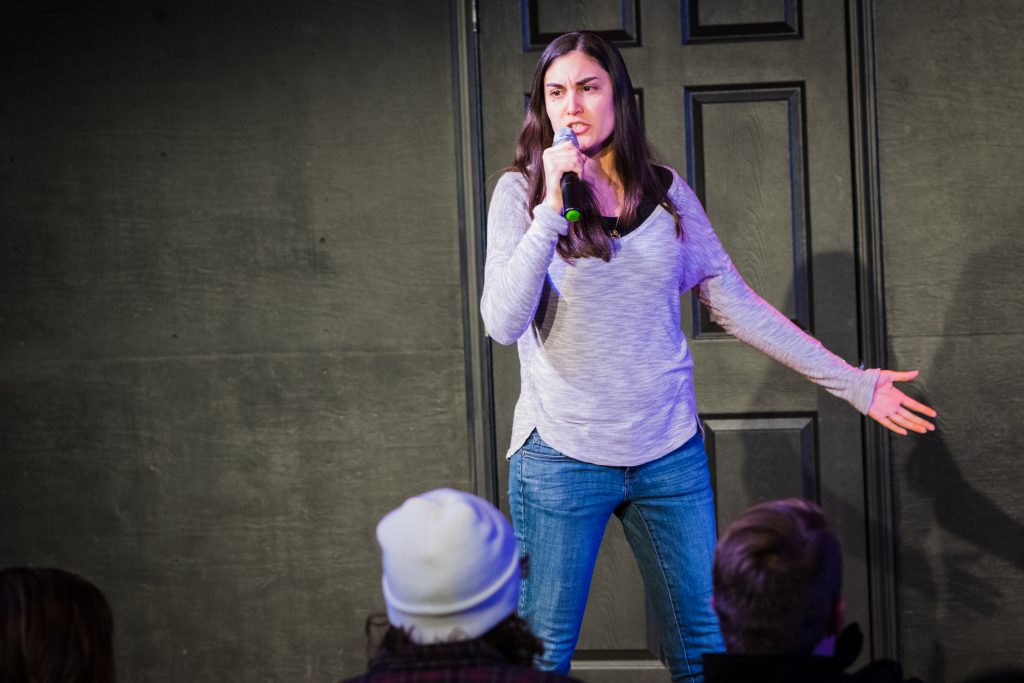
Andrés Lemus-Spont: Mishell, I’m curious about your…like where you see this going? You seem like a very thoughtful and also strategic person. [all laugh]
Maria Konopken: All true.
Andrés Lemus-Spont: And I’m curious what the plan is.
Mishell Livio: Well, it’s interesting that this series is about writing. Because next season — Season 4 — the performance teams will be doing improv-to-sketch. So, they will be improvising at their rehearsals — they will be essentially writing a sketch — and then on Tuesdays at the show they’re going to test the sketch out. Some of them will work, some of them won’t. The ones that work, they’re going to keep, they’re going to pocket. The ones that don’t, they’ll get rid of them, maybe they’ll rework them. We’ll do that until we have a fully written sketch revue. And I think the video sketch is a great way for us to expand and become something bigger than what it currently is. Is the short answer.
Andrés Lemus-Spont: [laughs] That’s a very short answer.
Mishell Livio: Continue to grow and expand. Right now we’re doing small videos, which will become longer and longer. We’re going to start serializing things. I screen the videos in front of the live audiences — what you saw tonight hasn’t been released yet — so I look and see what works and what doesn’t. If something doesn’t work, I look at the video and I rework it, I re-edit it, and I screen it again. And I see, “Okay, will it work this time? No, still didn’t work. Take it out!” So I’m constantly testing things to make sure, before I put them out into the public, so I know what works and what doesn’t. I’m also testing to see how things work, once I release them. “Oh, they like these characters. They like this idea. Okay, let’s take that idea and write another episode of it! Maybe we can serialize that idea. Maybe this character — there’s something within that character, let’s do something more with them.”
Video: “Birthday Funeral”: The video thumbnail shows two performers in black-and-white cut-outs against a yellow background. A white and red “GLx” logo is in the top left-hand corner and the superimposed title, “Birthday Funeral,” is displayed on a red banner in the bottom right-hand corner. The eyes of the performer on the left are closed and the performer is kissing the fingertips of one hand while poising the fingers of the other in a similar way. The performer on the right looks on with raised eyebrows. Video courtesy of Generation LatinX.
I’m also paying attention to, “Oh, this writer likes doing this. This person likes doing that.” I’m just looking at everyone and seeing what people like, what people are good at. And maybe sometimes people aren’t good at things, and I’ll push them to do it more. Because you’ve got to fail, I think, to know what you like and what you don’t, what you’re good at and what you’re not. I can’t tell you, you know, “You’re really not good at this thing.” [all laugh] You’ve got to find it out for yourself. So I’m always encouraging people to try and do things.
I want to keep expanding the video and writing departments because no one’s going to write for us! I mean, how could they? They don’t really know our experiences. If we don’t tell our stories, nobody else will. So I want everybody to be encouraged to get out there and write their own stories and produce their own things and expand.
Maria Konopken: And if something’s relatable, you’re going to laugh at it more. Like, even the therapist video tonight was very funny on a larger scale. But there’s one with little house figurines–
Mishell Livio: “Nuestras Casitas.”
Maria Konopken: –and there would be little jokes that — if you get it, if it’s part of your culture — it’s even funnier. So it’s fun to see those stories told. And also, on the writing team, to see the different perspectives and different types of humor that people have, too.
Video: “Nuestras Casitas”: The video thumbnail shows two performers in black-and-white cut-outs against a blue-grey background. A white and yellow “GLx” logo is in the top left-hand corner and the superimposed title, “Casitas,” is displayed on a yellow banner in the bottom right-hand corner. Both performers look at the camera and hold small, diorama-like models of houses out toward it. Video courtesy of Generation LatinX.
Marya Spont-Lemus: Who is the writing team? Are the directors for the live stage show the same as the directors for the video sketches? How does all of that work out?
Mishell Livio: No, it’s different! The improv teams, currently, are their own thing. Usually the directors for the improv troupes have 5-10 or more years of experience. They direct the teams, they are on various house teams at iO, they’ve graduated multiple programs. Also, if somebody just tells me that they’re interested in directing, I’ll develop them as a director. Maybe I’ll have them shadow someone else.
With the video sketch, those people submitted as writers, so they submitted packets. We read through the packets. Some packets we liked and some we didn’t. Depending if those people wanted to do different roles, we may have put them on the social media team or the marketing team or the improv team or something else. That’s how the writers developed. We also have videographers. And usually the videographers are editors and directors. So it’s very intricate. It’s a very difficult thing to do because there’s a lot of moving parts.
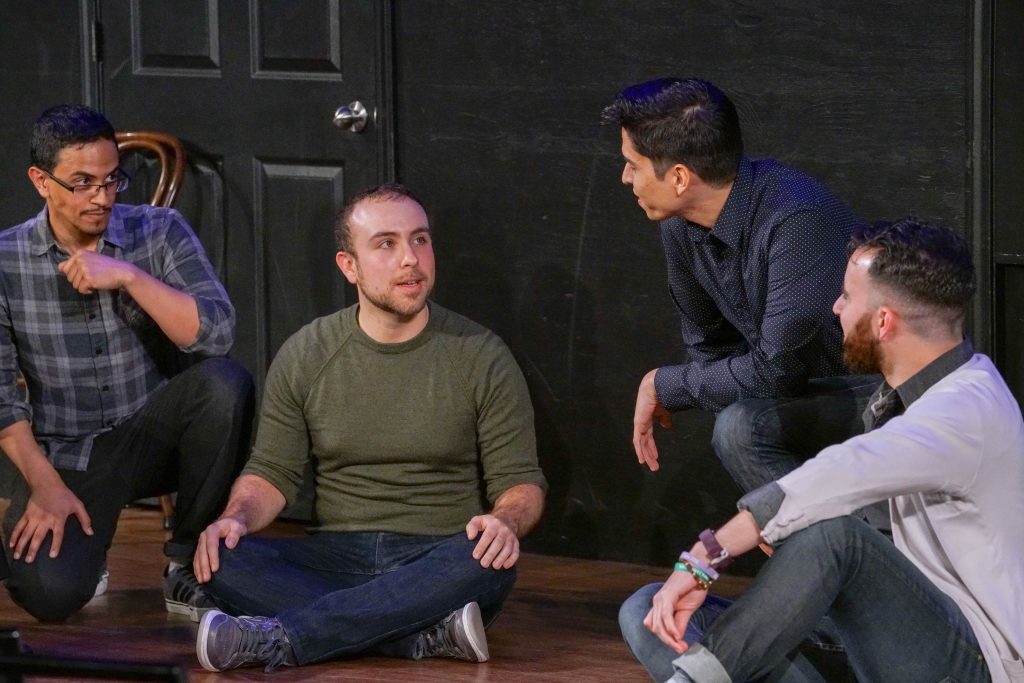
Marya Spont-Lemus: What roles in that process do each of you play? And how do those roles intersect with each other? Because it seems like you all play multiple roles within the ensemble and larger frame. Are you always playing multiple at a time, do you alternate through them, are you writing material literally for yourself as a person?
Mishell Livio: Usually we write material with specific people in mind from our performance groups. We’ll sometimes write stuff for ourselves as individuals, but I’ve found messy things in that — if someone’s like, “Wellllll, I wrote, and directed, and edited, and starred in this.” [all laugh]
Marya Spont-Lemus: “Get your own YouTube channel!” [all laugh]
Mishell Livio: Right, it’s like, why do you want to be a part of an ensemble? You’re your own ensemble. [all laugh] You don’t need us, you’re your own entity. But yeah, the video sketch team, a lot of times what they’ll do is pitch ideas. So everyone pitches two ideas around the room. We talk about those ideas. The next week they come back with a draft of it written. We all read the draft, we give notes, they come back with a second draft. I have a head writer, Alex Barontini, and he will say, “Okay, of these second drafts, these 1-3 ideas I’m going to present to you.” I look at them, Maria looks at them — she’s part of my production team — and we’ll say, “Okay, these two are feasible, I can see casting these people in it, I can see producing it this way.” Let’s say Jesse wrote it. I’m probably going to put a different director on there, just so we can get a different take on it. Usually the director is the editor. Then they send those first edits — like an assembly cut — to me. I see those assembly cuts, I say do this, do that, rework it. They do another edit on it. Then they send it to me. We screen it, we do an edit, we screen it, we do an edit. [all laugh] It goes online. Jesse does all of the graphics for us, so all of the logos and all that.
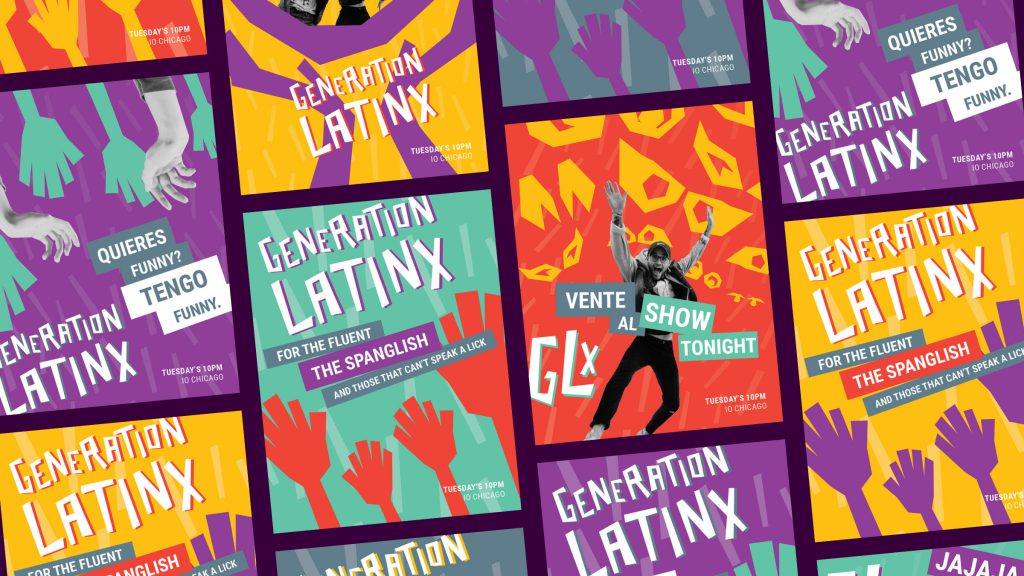
Marya Spont-Lemus: I was wondering! That’s great.
Jesse Pazmiño: Yeah. I basically design the whole brand identity for Generation LatinX, which also touches upon the video sketches or whenever we need graphic representation. I design, Mishell reviews. And that was the process with Mishell initially, too. I presented a concept, she gave feedback.
Mishell Livio: Yeah, it was a lot of, “What is this brand? What do you see? What do you like? What are some ideas?”
Jesse Pazmiño: Because at the beginning — I mean, I guess there really wasn’t one.
Mishell Livio: No. There was me! I mean, I was doing everything.
Jesse Pazmiño: So I brought it up to Mishell, “By the way, I’m a graphic designer.” [all laugh] “If you want a brand identity for Generation LatinX, I can create it. Do you want to do it?” And she said, “Go for it!” So I came up with some ideas, we started a discussion to define what the brand story actually was — because I didn’t know either. I wasn’t sure what we were trying to portray. And eventually I found a solution that I think is fun. It shows the energy and it’s also, I think, its own aesthetic. It’s not trying to be a “Hispanic” sort of brand, and I think that’s part of how it fits with us — it’s our own sort of take on what that means.

Marya Spont-Lemus: I did notice that “Generation” is written in English, but then in introducing the live show people also said “Generación.” I mean, I think it’s clear no matter which language — it’s a one letter difference — but I did notice that the title wasn’t written in both languages in the logo and on the website.
Mishell Livio: Yeah. [all laugh]
Marya Spont-Lemus: I mean, maybe it’s not–
Mishell Livio: No, you’re spot-on. You’re spot-on. That is correct. [pause] It is something I have thought about too — of, like, creating a different page. It’s just about expansion. You know, it’s like “NBC,” “NBC Latino.” [all laugh] You know what I mean? If we had enough of a following and enough interest to create a fully Spanish Generación LatinX, its own entity, then it could branch off.
Marya Spont-Lemus: And I didn’t mean it as a critique or anything. I just noticed because in the show the different teams — the “English” and “Spanglish” teams — were introduced differently, in speech. And that the logo just said “Generation.”
Mishell Livio: Yeah, and I’ve had people in the group even pitch me the idea of, like, having a foreign-born team versus a U.S.-born team. Because they’re like, “We have a different perspective — we don’t only identify as ‘American’! Our perspective is different. So it might be neat to have a South American team.” And I was like, “Yeah, if you can get enough people, then that’s something we could develop and do.”
Marya Spont-Lemus: Yeah, it was really incredible to see how much of the world was represented onstage tonight.
Mishell Livio: Yeah.
Marya Spont-Lemus: And I loved, too, that when people introduced themselves, they each said something about their personal heritage. That also struck me as really different from other shows I’ve been to — I mean, I don’t go to a ton of improv — where performers might say their name at some point but that’s it. But yeah, as a white person who is not Latinx who’s coming to see the show it still meant something to me to hear that, and I imagine it might mean something even more to an audience member who is like, “Oh, my family is also from Peru!” or something. Like, for me it was, “Oh, I feel even more of this connection to you because I know something about you as a person.”
Mishell Livio: Sure!
Marya Spont-Lemus: “Before I see you take on…75 different roles in the span of two and a half minutes.” Right? So there’s something about it that also functioned like intimacy-building or something, for me as an audience member and maybe for others. I thought it was really lovely.
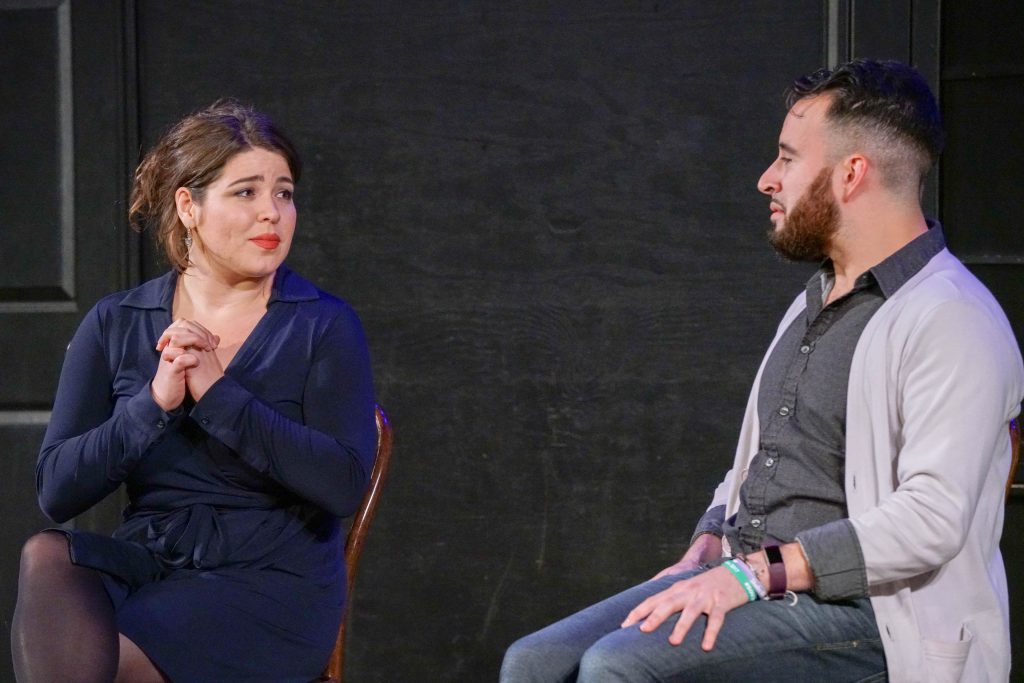
Maria Konopken: People can relate on an emotional level to anything, so if you can find something you have in common…. I mean, even beyond the countries, if someone is like, “Oh, I had a dog that would bark too” — I don’t know, whatever. [all laugh] People find the weirdest things! They’re like, “Yeah, the way you signed that check. I sign checks!” And when your focus is not on, like, “Are you guys Hispanic or Latinx?”, it’s on their characters, I think that’s a big thing.
Mishell Livio: I also think that — like another thing of “Latinx” or “white” or “Black” — it’s like, okay, but there are so many countries represented in any of those. You almost wipe away people’s individuality. It makes me upset when someone will say, “Well, I’m white.” I’m like, “Where, from Whiteland?” [all laugh] Excuse me, I’m sorry, but being Swedish is so different than being German is so different than being– Like, they are different. That’s one of the reasons I tell the ensemble, “You guys are different from each other.” Like Peruvian cultures are so different than Puerto Rican cultures are so different than Mexican cultures…. So I love that the performers do still retain their individuality, even though we are under this umbrella of Latinx.
Jesse Pazmiño: Well, you were saying how some people asked, “Can we do a South American team?” And I think that sounds great. But I also think that part of the appeal of the way it’s structured now is the fact that because everybody’s so different — this is something that sticks out to me, as somebody who grew up in South America, with one specific culture, which is Ecuadorian — those performers and writers are also exploring this new reality for us as individuals, which is being Hispanic in the United States. This U.S. pan-Latinx identity is something that didn’t always exist for us in the way it does now, and it’s something that we together are sort of creating with all team members. And I think that’s part of what you see onstage, it’s part of what we write on the sketch team, and part of what, in a way, is the new narrative that we are creating. It’s not necessarily just, “We’re going to do a Puerto Rican show” or “It’s a Mexican show.” Or, “We’re going to put in Mexican or Puerto Rican motifs to ‘make’ it a Hispanic show.” Nobody’s actually following that kind of agenda. It’s just, this is what we’re creating now because this is who we are right now in this particular place and time.
Video: “Who’s My Next Therapist?”: The video thumbnail shows five performers in black-and-white cut-outs against a green background. A white and purple “GLx” logo is in the top left-hand corner and the superimposed title, “Who’s My Next Therapist?”, is displayed on a purple banner in the bottom right-hand corner. The two performers in the center foreground hold microphones and look at the camera; one looks excited and the other pained. To the left and the right of them, three other performers, two holding microphones, look toward the center of the frame. Video courtesy of Generation LatinX.
Andrés Lemus-Spont: I mean, I feel like the connection to television seems pretty direct. And thinking of this show here at iO feels unlike what a lot of television was from when I was growing up, which was, you know, “Spanish-speakers get their channels.” But that’s where they are. They’re very few places other than that. And iO not just feeling like, you know, ABC, and then if you want to go to Univisión, you go to Pilsen or whatever. I think it’s great that this show is here at iO as opposed to somewhere separate. I don’t know how everyone in this audience got to this show, but I like to think that some people just came because they come to this place and admire the stuff that comes out of it, and you’re the next show they want to try and it’s like, “Oh, I don’t even know a lot of what they’re saying but it’s still funny.”
Maria Konopken: Right. And you’re seeing a push now, like I said before, of people creating their own, because there wasn’t that space. Two years ago, none of this existed. It’s nice to see that people are coming up, and that even more groups are coming up. It’s a very interesting time to be part of it, especially for people who may have been the only Hispanic person on their team. There’s still a lot more work to do, but it’s nice to be like, “I’m going to come to this show, Tuesdays at 10 o’clock, and I feel at home.” Maybe compared to other teams that are in this theater or other shows in the city.
Mishell Livio: Yeah. And from this ensemble, a lot of people have met and created little things outside of it. I think three or four groups have come out of this. Which is awesome!
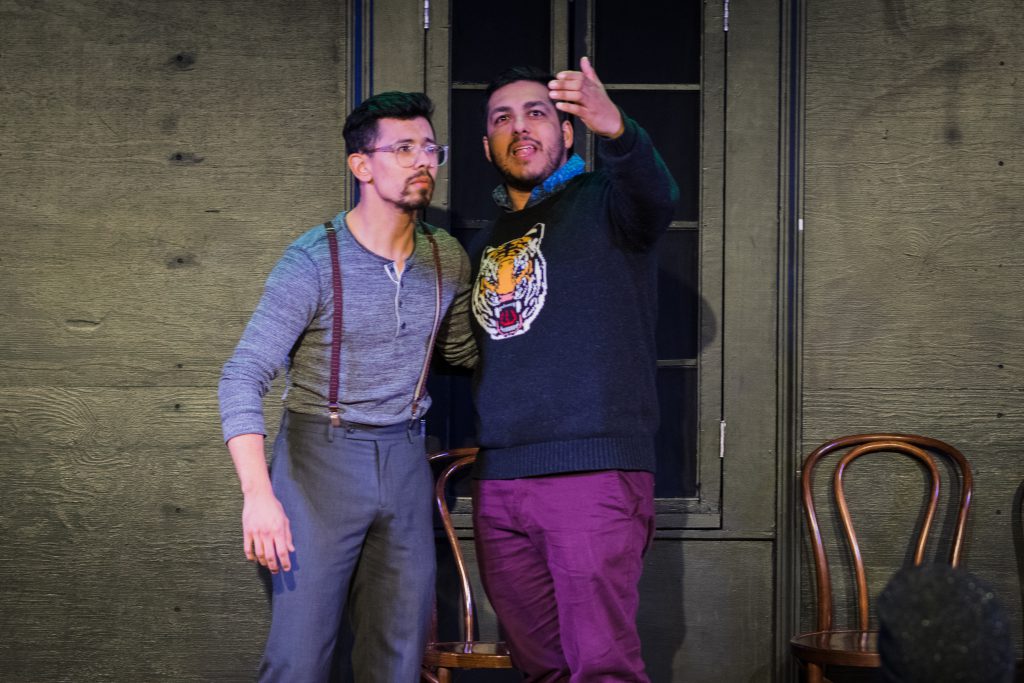
Maria Konopken: Right. And then, outside of this, I’m working on a project and we needed someone of Latin descent that’s also a strong writer. So I was like, “Well, Neftali [Morales] is this amazing writer, he has this amazing idea,” and then Neftali cast people from Generation LatinX. And you see, as Mishell said, performers coming up and creating their own, but still coming back and being part of this ensemble. And maybe they can’t do it one session, but they’re still coming to the shows and showing support where they can.
Marya Spont-Lemus: And — I’m not quite sure how to point it out or draw the connection — but, Mishell, you were talking earlier about the importance of how you are helping to train performers or reviewing their resumes or telling them they need new photos or things like that, which is all really important. But then, of course, “arts and entertainment” is not only not a meritocracy, like most things aren’t, but seems particularly, like, nepotistic in a way?
Mishell Livio: It can be.
Marya Spont-Lemus: I guess it just seems like it can be the kind of thing where people cast people they know or whose work they know, to the extent that some people might just cast their friends or people they went to theater school with or even were in high school drama camp with. But also the ways that one can– I don’t necessarily want to say that you can, like, “hack” that, but just how one can insert their own networks into other systems or cycles.
Mishell Livio: I think in our case it’s just a pool. A good thing about this is, there were Hispanic people at iO before — but they were over here and over there and over here and over there. And a lot of times people will say, “Well, I mean, *tsk* I put out a casting call for Hispanic people and they didn’t respond. [shrugs] So I just whitewashed it!” [all laugh]
Marya Spont-Lemus: And that’s what I think I was trying to get at — like how you, in addition to “creating your own,” create a network that intersects with or disrupts and benefits from that.
Mishell Livio: So now, a lot of casting people will come to me! “Hey, I’m looking for a Hispanic person.” And I’ll be like, “Okay, I have an ensemble — of 75.” [Jesse laughs]
Maria Konopken: Right.
Mishell Livio: And, at least you’re then telling these 75 people, “Go tell all your friends as well.” So it’s just a concentration. I’ve built a network. Essentially. So if you are looking for a Hispanic performer you can at least come here and get the word out so that you aren’t whitewashing these things.
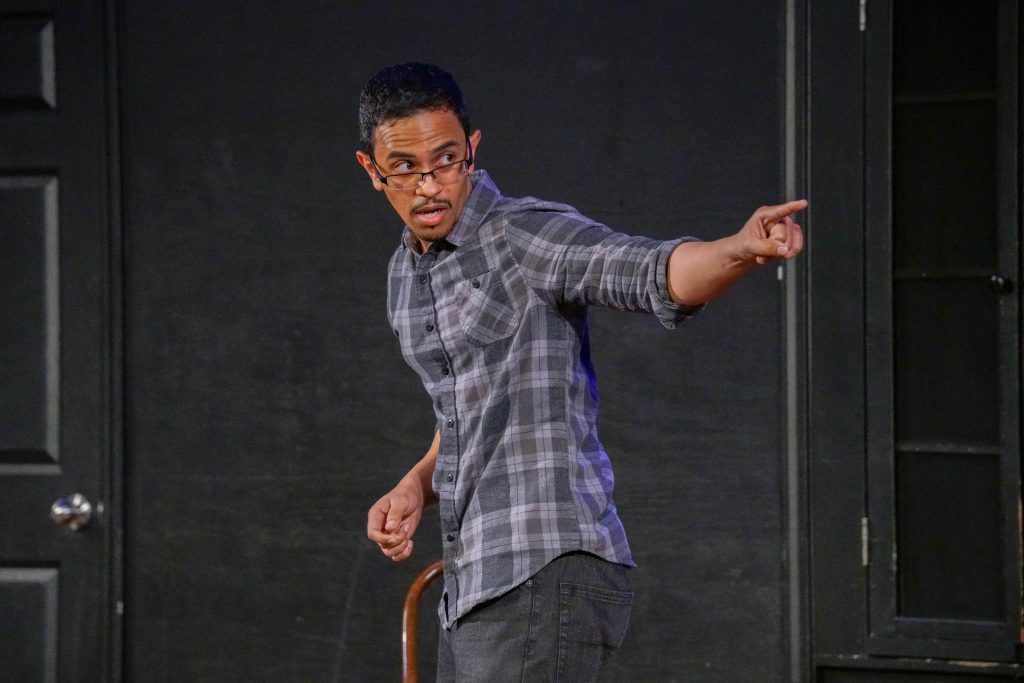
Maria Konopken: Right. You can come here, and then the next step is making sure that you are that professional. Because a lot of this knowledge and a lot of this trial and error — at least I’ll speak for myself — I had to figure out on my own. And maybe ask somebody, but then I was nervous, too, because, you know, people are very competitive in weird ways. What Mishell’s really doing here is, “Here’s the steps to do it. Here’s the tools. You gotta go do that.” And not holding their hand. And if you’re willing to listen, great. If you’re not? That’s on you. You know?
Mishell Livio: And there are some people who are not going to get cast because they don’t show up! Or they don’t do the work or have the training yet. They’re still green. And, like you’re saying, it’s about nepotism but also, “Well, if you’re not good enough, you’re not going to get cast.” So, like, I’ll yell at people, [all laugh] “You need to be on time! You need to show up! You need to earn these things.” People aren’t just going to give you things. You need to earn it. You need to be the best. I don’t want any of you saying, “Well, I got cast but I was token.” “No. You got cast because you were great.” Be great. Earn these things.
Maria Konopken: Mmm hmm. And I still get told that a lot. One that made me really upset was, “Oh, it’s so cool that you’re doing Generation LatinX and you got it because you’re on another POC team.” I was like, “No, I showed up, I go to the stuff, and I work hard.” Also, yeah, Mishell and I have a friendship, but Mishell can depend on me to show up–
Mishell Livio: She’s there before me! [all laugh]
Marya Spont-Lemus: “Does Mishell cast all her friends?” [all laugh]
Mishell Livio: I don’t have that many friends, I can tell you that right now! [all laugh]
Maria Konopken: But like there’s– Where was I going with this? [all laugh] Oh! So that comment made me upset. And this is by somebody outside of this whole thing who’s basically saying that I’m getting opportunities because I’m on another POC team that’s really popular in the city. So then I went — I was coaching — I went to that class and spent the first 20 minutes on why this is important, why you need to show up on time, and why these little things matter. They’re going to say it regardless, but I got a resume of seven years and hard work ethic to, like, back up my B.S. [all laugh] I do. No one can tell that to me and get away with it, basically. Yes, certain opportunities will get me seen by other people. But then it goes deeper, can you depend on me? Can I show up and do good work? And a program like this didn’t exist when I first got here, so I didn’t get to take that and run with it. I had to figure it out on my own, and that may be why I am so passionate about the work we do here and the work I do with Matt Damon Improv and on my own.
Mishell Livio: I think also, if these people are great, you won’t be pigeonholed to these token roles. Because you’re great! So you can do anything! And opportunities will be opened up to you. So that’s the point, is to go beyond stereotypes and be seen as people. Like, maybe you might get cast as some sort of stereotype because that’s what people think of first? But if you are awesome you can do anything and you can transcend these things. That’s really our goal.
Maria Konopken: And you can see the people who are doing the work, that have been an understudy and are now on the main cast. It warms my heart to see them — even tonight — blossom. Like, “Oh my god, you wouldn’t have done that six months ago!”
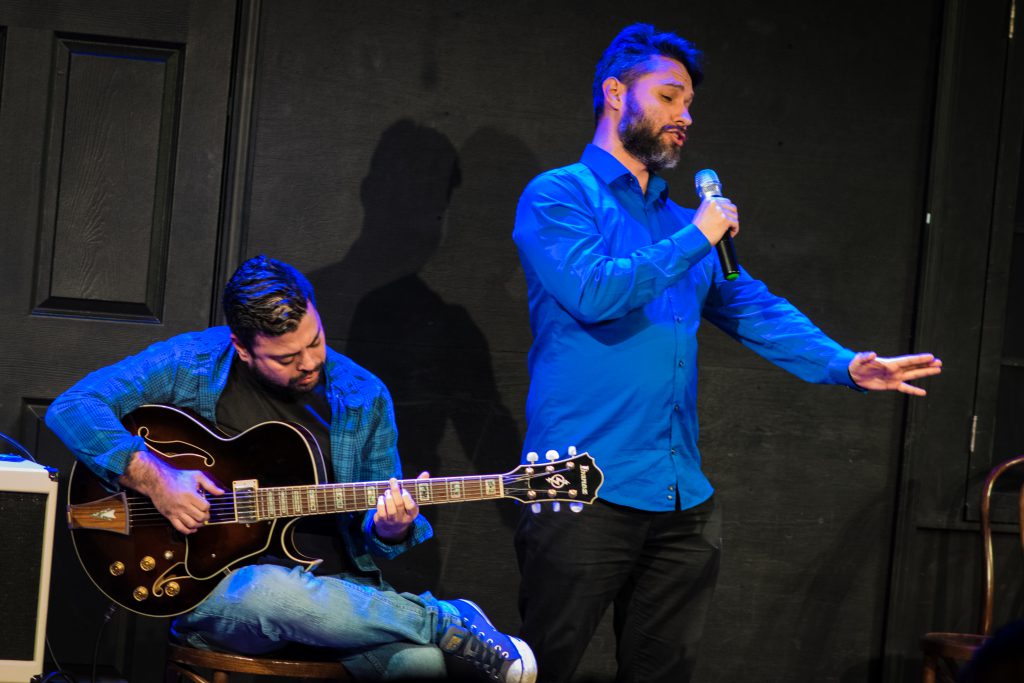
Marya Spont-Lemus: Given some of what we’ve just been talking about, I’m wondering how the show has changed over time or how the structure and shape of the show changes. Especially with the video sketches, it seems like a lot of tuning and shifting and experimenting happens. And my understanding from an email from a while ago was that “English” and “Spanglish” shows happened on different weeks — I’m not sure if I understood that correctly — but tonight both happened, as different sets within the same show. I’m just wondering how the show itself has developed.
Mishell Livio: Yeah, first when I developed the show I had an opening team — because no one knew who we were or what the show was. There’s four stages here, and each stage has three or four shows a night, so it’s impossible for everyone to know about every show and group performing. So what I would do is I would have, for example, the English team perform and, opening for them, I would have a house team from iO that had at least one Hispanic member, which usually was a small percentage of the teams. So, essentially, I would get house teams to watch our shows, because they would be the opening teams, and they’d be like “Oh, this is interesting.” Because they were part of the show, they realized what we were. And then we were able to grow.
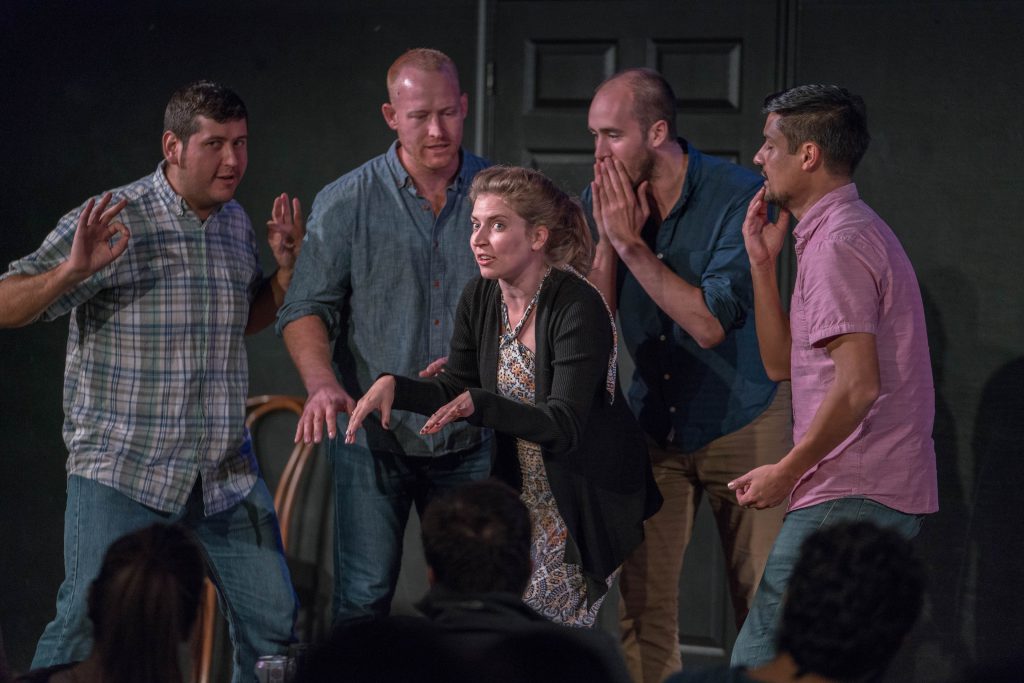
Andrés Lemus-Spont: Was that also a strategy to get buy-in from other ensembles at iO? Because I think it’s clever! It’s like, “We’re going to have you be the first act — but that means you’re going to have to be here, you’re going to have to see these people, who you otherwise wouldn’t have seen perform.”
Mishell Livio: Right. Exactly. [all laugh] Essentially I was inserting our ensemble into the iO community. But also, our ensemble had the opportunity to see other ensembles and learn from them too.
And there aren’t a lot of Hispanic performers at this theater. We’ve grown in numbers over the past year, but we still aren’t really part of this! So I’m going to continue to make us part of this by inviting established teams to be in the show. There’s no separation; I’m a part of you and you’re a part of me and [claps hands together] that’s it. It is, “Hi! We’re here.” [Jesse laughs]
Maria Konopken: And, to complete that circle, the performers here as part of Generation LatinX are then taking classes at iO.
Andrés Lemus-Spont: Yeah. I think that’s a really wonderful example. It kind of transcends this idea of performance because, often, there’s this, “There isn’t a Black or brown this,” so we make our own with Black and brown people, for Black and brown people. And that’s great! But that’s also limiting because, by separating yourself from those with access and power and whatever and connections–
Mishell Livio: You’re segregating.
Andrés Lemus-Spont: –you’re doing yourself a disservice in that way.
Mishell Livio: I never wanted to be segregated. From the start, I was like, “I want to be integrated.”
Andrés Lemus-Spont: And inclusive, like you said earlier.
Mishell Livio: Absolutely. Because they won’t– We’re telling our stories but if we’re segregated, we’re telling our stories to ourselves. We already know our stories! [laughs] I want to be part of the larger entertainment community. Almost 20% of the population is Hispanic. So 20% of every theater should be Hispanic, 20% of businesses should be Hispanic. We should be!
Marya Spont-Lemus: And in Chicago it’s much higher than 20%.
Mishell Livio: It is! In Arizona it’s much higher, too.
Maria Konopken: Yeah. In Arizona 30% of the population is of Latin descent.
And the work is good, so if you come and you have a good time, whether you can relate to the story or not, the work is good. And some people see it and are like, “Oh, I want to learn about how to do that.” You know? It’s better than anything you could ask for.
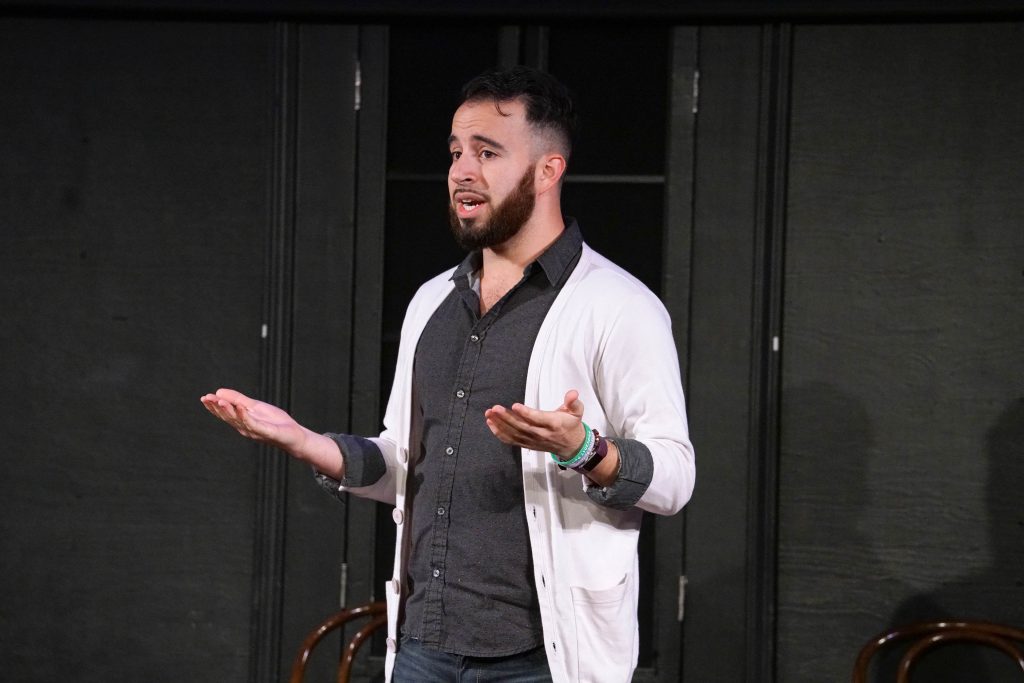
Marya Spont-Lemus: Are there particular figures, groups, or organizations who have shaped or influenced your own work in improv or that of this ensemble? Do you have frequent collaborators within the city, or how do you engage with broader networks? Jesse mentioned the Chicago’s Diverse Comedy Community to me. Or other work that you are excited about?
Mishell Livio: One of the biggest things was that television station I mentioned, Sí TV, which was for Latinx people who speak English. I thought that was really awesome. And a lot of television I have seen recently. Like Shonda Rhimes’ things are great because there’s so many different ethnicities represented. Superstore I think is amazing.
Maria Konopken: Superstore. Jane the Virgin. And it’s great that on Superstore, America Ferrera is directing some of those episodes. On Jane the Virgin, Gina Rodriguez is directing some of those episodes.
From a Chicago standpoint, I am inspired by people like Wendy Mateo, Lily Be, and groups like B.A.P.S., PREACH!, and can I say my own group? Yes, I am inspired by the women of Matt Damon Improv. People come to these shows because we are people of color, but they spread the word because we are talented. And these groups and some of their members have opened for Generation LatinX, which is amazing and helps to build a community plus celebrate different cultures.
Mishell Livio: Yeah. In February we had predominantly Black teams open for Black History Month. Because I think their cultures are very important as well, and we have Afro-Latinx people within this group!
Maria Konopken: For opening sets we had B.A.P.S., which does a show here at iO; PREACH!, who does a show here as well, on Friday nights; EbonyEssenceJet; and Your Dark Embrace. A lot of groups came in and saw it. It’s just nice to have different stories being told. And as the show evolves, who knows what will happen?
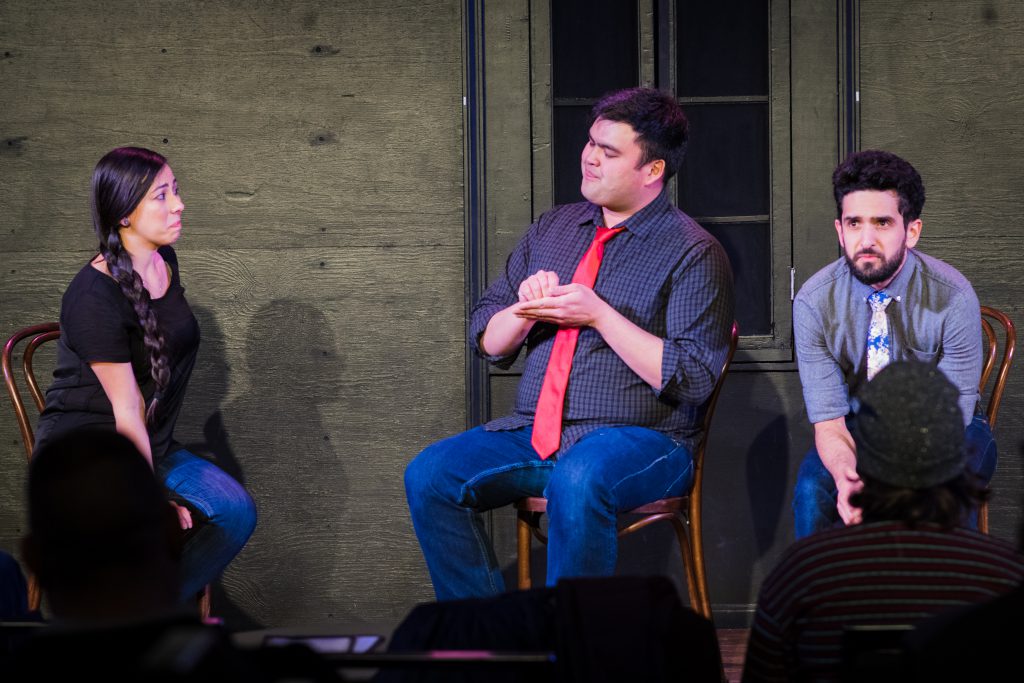
Marya Spont-Lemus: So what is coming up in Season 4? Or are there other projects that are coming up — you mentioned doing outreach to colleges?
Mishell Livio: Yeah. Outreach is great. I think the more we do, the bigger we grow, the bigger and louder our voice is, the more likely it is for us to be able to get into different schools and do these outreach programs. But if we don’t have that clout, and if no one knows who we are, then they can’t hire us. So it is always a goal to get involved in these educational programs, it’s just a matter of them saying yes to us and then us doing it.
And more writing, I think. I want the show to become more and more polished. Again, with the more popularity we gain, so that when people are hearing about the show and come to it, they’re seeing a more and more polished show.
Video: “Your Forever Home”: The video thumbnail shows four performers in black-and-white cut-outs against a purple background. A white and blue-grey “GLx” logo is in the top left-hand corner and the superimposed title, “Your Forever Home,” is displayed on a blue-grey banner in the bottom right-hand corner. A performer with a terrified expression, mouth and eyes open wide, occupies half of the frame, in the foreground. Smaller behind her are three performers: two smile and look at the camera, one while brandishing a knife, and the third performer wears a homemade mask with uneven eyes cut out. Video courtesy of Generation LatinX.
Marya Spont-Lemus: My last question is — and sorry, this is kind of cheesy but it’s just coming to me — because most of you participated in this live, ephemeral show tonight, or even just from this conversation, what are a few words that you’re leaving the night with? Or something that happened onstage that you’re leaving the night with?
Jesse Pazmiño: [laughs] Jumping off a window. [all laugh]
Mishell Livio: Commitment, excitement, growth.
Maria Konopken: Commitment. And challenge too. On the stage in an improv set, I think — and this is just me personally — “My goal is to do this in the set,” just to challenge myself. My goal for the last month, in general in shows I’ve done, is to be more physical.
Marya Spont-Lemus: [laughs] You really seemed to achieve that tonight! [Jesse laughs]
Maria Konopken: I know that on this stage I can do that and people are going to, like, “yes and” it — because that’s what you do. But yeah, there’s a commitment. And improv is fun for me in certain atmospheres and this is one of them, so I like coming to do it. If it wasn’t fun, I wouldn’t do it. [laughs] And when watching the show, I’m just laughing at them being silly and also seeing how they improve each week, which I enjoy.
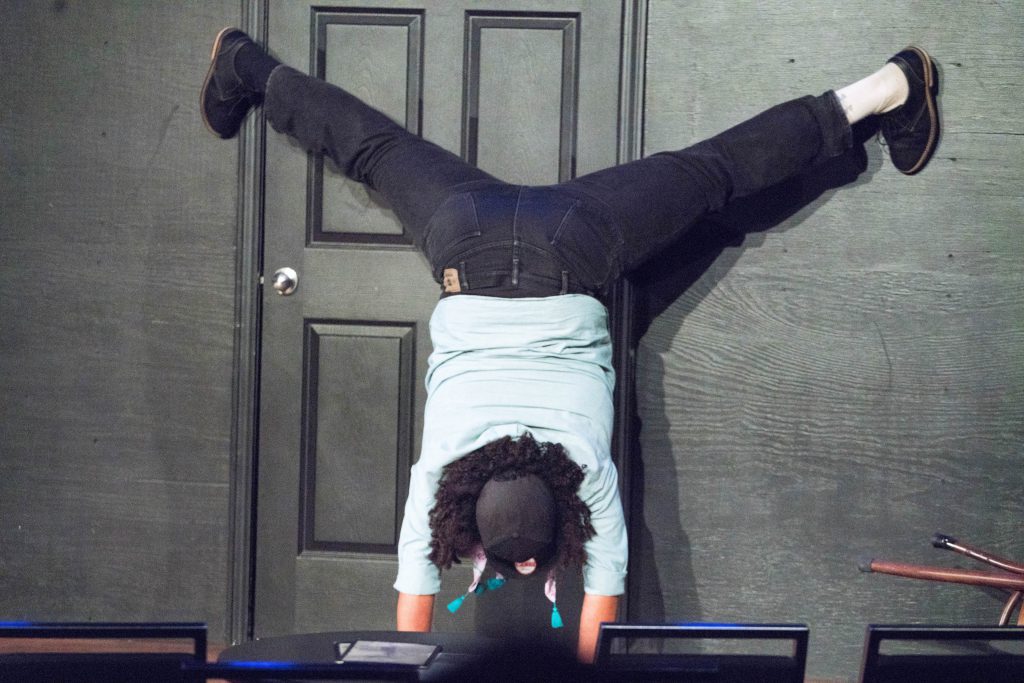
Mishell Livio: Yeah, I love seeing their growth. This is the end of the third season now, and I can see everyone’s growth. I’ll see little mistakes happen onstage and think “Oh no…” — and then I can see them [snaps fingers] correct. They couldn’t have corrected those things at the beginning of their career. So it’s wonderful to see them — because mistakes in improv are beautiful — it’s just seeing what you do with those mistakes and how you can turn them positively. I saw so many little mistakes tonight, and I saw so many of them turn positively. And you’ll hear a laugh and you’ll be like, “That’s the edit. And somebody’s running across the stage they found the edit it’s so great yeeeesssssssss!”
Maria Konopken: I coached first season and was screaming “edit” in classes. “Edit this.” And they’re like– But I’m like “I don’t care. Edit this. I can’t watch it anymore.”
Mishell Livio: “It’s done. It’s done! This is done!” And they did it! I just get so excited when they say yes to each other’s ideas, or they both come out and you can see the terror in, like, “Oh, I thought I was a swan, but we’re at a funeral!” [all laugh] And them just incorporating both of those ideas and figuring it out. And not panicking. Which is great!
Jesse Pazmiño: It’s exciting to see that happen because, as they keep meshing as an ensemble, they keep also showcasing themselves as performers — both as individuals and together. As a writer, that’s exciting to see. Because the writers come watch the show and, when the performers get to that point, we can see exactly how that person could be used in a sketch. You know, “Oh, yes, I can see what character Luis [Roberto Castelló] could be.” Or, “Where can I push Luis to go, since I saw him go here this week?” And that makes writing more exciting, because you know what you’re playing with and what buttons to push for the performers to perform their best. Because, as writers, we want to highlight them. So it’s kind of this cycle.
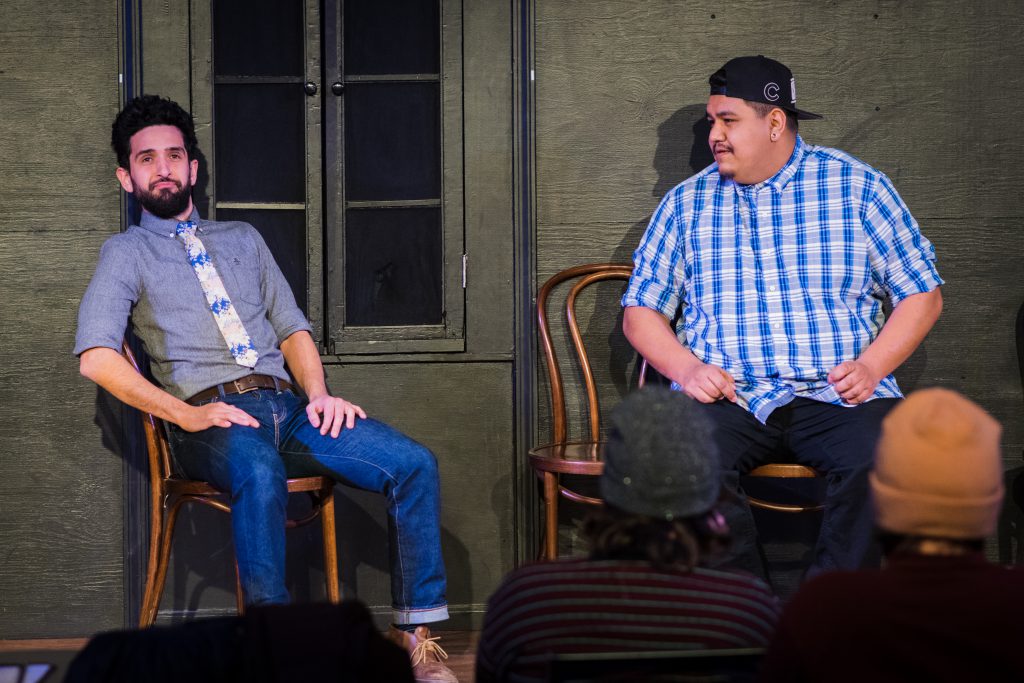
Marya Spont-Lemus: Well I was saying earlier how– Who was the performer in the striped shirt?
Maria Konopken: Alexis [Alvarado].
Marya Spont-Lemus: Alexis. I was like, “I loved his characters’ darkness.”
Mishell Livio: Yeah.
Marya Spont-Lemus: You know? He had a really dark, lovely sense of humor that totally worked for me. And I was like, “Yeah. That is what I want to watch.”
Maria Konopken: And he’s one of the performers that started out as an understudy. I remember, he came to every rehearsal and I’d be like, “You’ve got it, just do it, just be weirder!” [all laugh]
Marya Spont-Lemus: It was so wonderful!
Maria Konopken: Yeah. He’s funny by himself — just what he says — but he’s definitely taken advice from each coach and Mishell, and he started taking classes at ComedySportz, so he’s making the commitment, he’s really listening. Look at what happens.
Mishell Livio: He’s a prime example of someone who has taken advantage of the opportunities and come up through the program. Like I told him, “Take more classes, do this thing.” And he’s like, “Okay!” “See more shows.” “Okay!” “Stop asking questions.” “Okay!” [all laugh] I mean, he has grown so, so much. He’s great.
Maria Konopken: And he goes to a lot of shows. He was just at a show I performed in on Friday!
Mishell Livio: Yeah. Very supportive.
Maria Konopken: And he has this thing — that even I wish I had, where I could say something and everything I say is funny? — and he has that, already. So now, if you just work on it? Imagine where you can go with that.
Marya Spont-Lemus: Any final things anyone wants to share?
Jesse Pazmiño: I know we already covered this, but I think the special flavor that this team has is that sense of family. Because, yeah, we all have different goals, but what Mishell has created is a place where, at this moment in time, we’re all, like, holding hands. In a good way. Helping each other develop those goals and those dreams. And it’s really special! I think that that’s really what this is about, at the end of the day. And we just get to share that energy with the rest of the audience.
Featured image: Thumbnails for Generation LatinX video sketches, designed by Jesse Pazmiño. This image shows an oblique grid of parts of nine video thumbnails. Each thumbnail has the “GLx” logo in its top left-hand corner, actors in black-and-white cut out against a solid-color background, and a title (e.g., “Birthday Funeral,” “Chola Wisdom,” “Casitas,” “What is GLx?”, “Your Forever Home”). Across the images, performers have a variety of expressions, costumes, and props. Image courtesy of Generation LatinX.

 Marya Spont-Lemus (she/her/hers/Ms.) is a fiction writer, interdisciplinary artist, and educator focused on teen creative, leadership, and professional development. She lives and works on the Southwest Side of Chicago. Follow her on Twitter and Tumblr.
Marya Spont-Lemus (she/her/hers/Ms.) is a fiction writer, interdisciplinary artist, and educator focused on teen creative, leadership, and professional development. She lives and works on the Southwest Side of Chicago. Follow her on Twitter and Tumblr.
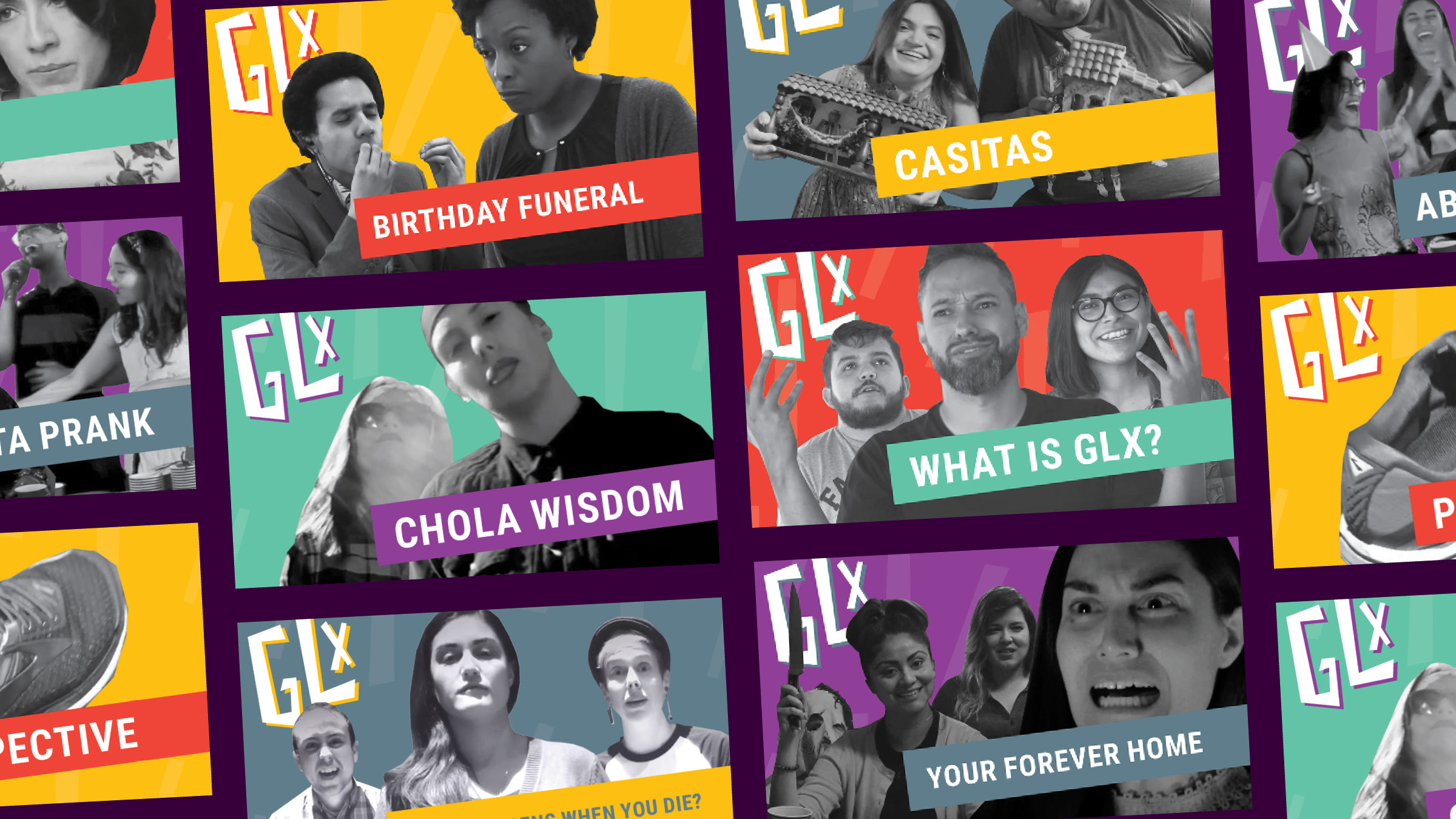
![[placeholder image]](https://sixtyinchesfromcenter.org/wp-content/uploads/2020/12/Quenna-Lené-Barrett_Headshot-300x99.png)
